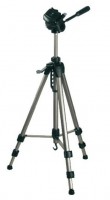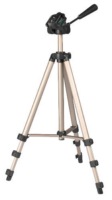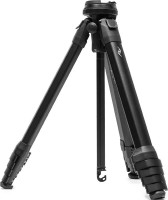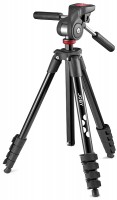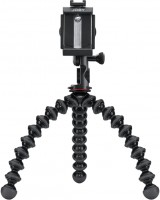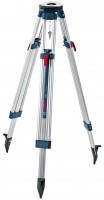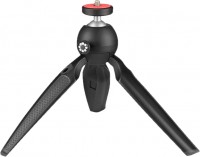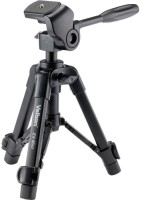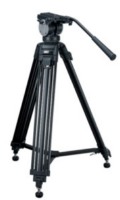Tripods Manfrotto
All Tripods Advanced filters → |
You might be interested in
Tripods: specifications, types
Type
— Tripod. Tripods of traditional design, known as "tripods" or "tripods": three legs with a camera platform on top. This design is able to confidently stand on almost any more or less horizontal surface, regardless of irregularities — all legs will find support anyway. Note that in floor models (see "Installation") the platform is often mounted on a retractable bar and can be adjusted in height, and telescopic legs — in length; in the desktop, such adjustments are not provided, but there they are not particularly needed.
— Flexible tripod. Tripods with flexible legs. Most often, such a device looks like a table tripod (see "Installation"), the legs of which can be bent in different directions; there are also more original design options — for example, a flexible "neck" fixed to the edge of the table with a clothespin. Anyway, this design provides extensive features for adjusting the height of the tripod and the position of the camera. And many models can not only be placed on a flat surface, but also fixed on handrails, tree branches, etc., bending the legs so that they tightly wrap around the support. However, note that the main part of flexible tripods is intended for phones and action cameras, in extreme cases — portable digital "soap dishes"; such models are poorly compatible with SLR cameras. This is due to the fact that under heavy weight, the legs can simply “break apart”. For the same reasons, flexible tripods are not made...on the floor — the weight of the structure itself would be too large.
— Monopod. A monopod is a “one-legged” analogue of a tripod — a bar, on top of which the camera is attached. With the base of the rod, the operator rests on the ground or other support, in extreme cases — in his own belt, pocket, etc. At the same time, the camera must be held with hands, because. a monopod cannot stand on its own (with the exception of rare models with additional support — see below for details), so such a device, unlike a classic tripod, is not capable of completely smoothing out all fluctuations. On the other hand, this moment is not so often critical; At the same time, monopods are lighter, more compact and mobile, they are perfect for shooting with constant movement from place to place. Note that some tripods are capable of transforming into monopods (see below), however, such models are referred to in our catalog as classic tripods.
— Clamp. A device in the form of a tripod head mounted on a screw clamp. Such a clip can be attached to the edge of a countertop or other surface, on a railing, the edge of a window opening, a pipe, a tree branch, and other similar places. This can be a real lifesaver in cases where there is no suitable platform for a more traditional tripod nearby; At the same time, the clamps also have a very compact size, which makes them easy to carry. On the other hand, the need for such devices is quite rare — in most cases, a classic desktop tripod turns out to be more convenient. So the clamps did not receive much popularity.
— Shoulder. Tripods for carrying the camera based on the shoulder — more precisely, on the upper part of the operator's body. They can have a different design: a bracket with stops for the chest and back, fixed with a belt obliquely over the shoulder; device with an emphasis for a shoulder and two handles for both hands; “a bed with a butt” for holding the camera in the manner of a rifle, etc. Anyway, it makes sense to pay attention to shoulder tripods if the operator plans to constantly move from place to place — such models are created for such shooting.
— Flexible tripod. Tripods with flexible legs. Most often, such a device looks like a table tripod (see "Installation"), the legs of which can be bent in different directions; there are also more original design options — for example, a flexible "neck" fixed to the edge of the table with a clothespin. Anyway, this design provides extensive features for adjusting the height of the tripod and the position of the camera. And many models can not only be placed on a flat surface, but also fixed on handrails, tree branches, etc., bending the legs so that they tightly wrap around the support. However, note that the main part of flexible tripods is intended for phones and action cameras, in extreme cases — portable digital "soap dishes"; such models are poorly compatible with SLR cameras. This is due to the fact that under heavy weight, the legs can simply “break apart”. For the same reasons, flexible tripods are not made...on the floor — the weight of the structure itself would be too large.
— Monopod. A monopod is a “one-legged” analogue of a tripod — a bar, on top of which the camera is attached. With the base of the rod, the operator rests on the ground or other support, in extreme cases — in his own belt, pocket, etc. At the same time, the camera must be held with hands, because. a monopod cannot stand on its own (with the exception of rare models with additional support — see below for details), so such a device, unlike a classic tripod, is not capable of completely smoothing out all fluctuations. On the other hand, this moment is not so often critical; At the same time, monopods are lighter, more compact and mobile, they are perfect for shooting with constant movement from place to place. Note that some tripods are capable of transforming into monopods (see below), however, such models are referred to in our catalog as classic tripods.
— Clamp. A device in the form of a tripod head mounted on a screw clamp. Such a clip can be attached to the edge of a countertop or other surface, on a railing, the edge of a window opening, a pipe, a tree branch, and other similar places. This can be a real lifesaver in cases where there is no suitable platform for a more traditional tripod nearby; At the same time, the clamps also have a very compact size, which makes them easy to carry. On the other hand, the need for such devices is quite rare — in most cases, a classic desktop tripod turns out to be more convenient. So the clamps did not receive much popularity.
— Shoulder. Tripods for carrying the camera based on the shoulder — more precisely, on the upper part of the operator's body. They can have a different design: a bracket with stops for the chest and back, fixed with a belt obliquely over the shoulder; device with an emphasis for a shoulder and two handles for both hands; “a bed with a butt” for holding the camera in the manner of a rifle, etc. Anyway, it makes sense to pay attention to shoulder tripods if the operator plans to constantly move from place to place — such models are created for such shooting.
Monopod transformation
Possibility of converting a classic tripod with three legs into a monopod(see "Type"). One of the options for such a transformation involves attaching one of the legs to the central bar and removing the other two, but there are other ways. Anyway, such a model can be useful for those who have to use different types of camera stands — instead of two separate devices, you can purchase one and use it in one form or another, according to the situation.
Mount
The type of surface the tripod is designed for. This division applies only to classic tripods (see "Type"), as Almost all monopods are somehow designed for outdoor installation.
— Outdoor. The maximum height (see below) of such tripods is usually comparable to the height of a person, which allows them to be placed directly on the ground. Such tripods are the most versatile, as a result — the most common. Their disadvantages are significant dimensions and weight, as well as (with some exceptions) poor suitability for macro photography.
— Desktop. Desktop tripods are small in size and are designed for shooting from a table, stone, curb, or any other elevated surface. They are very compact, often having a weight and dimensions comparable to the cameras themselves, which allows you to transport them right in your bag or even in your pocket. Tabletop tripods are also good for macro photography. On the other hand, they are less versatile than outdoor ones, because in most cases require an appropriate elevation. In addition, their maximum load (see below) is usually significantly less.
— Outdoor. The maximum height (see below) of such tripods is usually comparable to the height of a person, which allows them to be placed directly on the ground. Such tripods are the most versatile, as a result — the most common. Their disadvantages are significant dimensions and weight, as well as (with some exceptions) poor suitability for macro photography.
— Desktop. Desktop tripods are small in size and are designed for shooting from a table, stone, curb, or any other elevated surface. They are very compact, often having a weight and dimensions comparable to the cameras themselves, which allows you to transport them right in your bag or even in your pocket. Tabletop tripods are also good for macro photography. On the other hand, they are less versatile than outdoor ones, because in most cases require an appropriate elevation. In addition, their maximum load (see below) is usually significantly less.
Features
General purpose tripod. Note that many models combine several applications; see below for more on this.
— For cameras. Tripods designed for cameras. When choosing such a device, note that not every photo tripod is able to withstand a massive “reflex camera” with advanced optics, so the allowable load on the structure should be clarified separately. As for the features of the device, models designed only for cameras (and for nothing else) are designed more for holding the camera in a stable position than for quickly changing this position. On the other hand, the design may include various devices to improve the installation accuracy — levels, azimuth scale, separate adjustment along 3 axes, etc. If the tripod also allows other uses (with video cameras, telescopes, etc.) , its design features are often determined by these specialization options, camera compatibility can be provided as an option.
— For video cameras. A distinctive feature of most tripods designed for video cameras is a characteristic long handle attached to the platform. Using such a handle, the operator can simultaneously control the tilt and turn of the camera and quickly change its position — this can be critical when shooting video, when you need to quickly capture various areas of the scene being shot into the frame. However, desktop models (see "Installation") may not have a handle. Tripods “only for video cameras”, i...n addition, have an elongated platform, however, such a strict specialization is relatively rare, most models for this purpose can also be used with cameras (especially since many modern cameras also support video shooting).
— For telescopes and binoculars. Tripods suitable for use with telescopes or binoculars. Modern telescopes are most often equipped with their own tripods, and binoculars do not need such a support so often. Therefore, there are few models with this application option, and even fewer specialized only for telescopes; most often this purpose is combined with the possibility of installing a camera. However, the characteristics of such tripods are very diverse — from models with the simplest ball heads (see "Type of head") to advanced designs with a 3D mount and specialized "astronomical" functions. It is also worth considering that telescope manufacturers may use their own original mounts, so be sure to check compatibility before buying.
— For phones and action cameras. Tripods designed for use with smartphones, action cameras and other similar sized devices. The specificity of such devices depends on whether they can be used with other types of equipment. So, tripods only for smartphones / action cameras almost all have the form of compact desktop structures (see "Installation") — among other things, portability in this case is more important than the versatility of the installation. But models that are also compatible with cameras and/or camcorders may also have a floor version. Note that anyway, before buying, it's ok to clarify the compatibility of a tripod with a specific gadget: smartphones are usually installed in a universal clamp, but an action camera may require a proprietary mount.
— For cameras. Tripods designed for cameras. When choosing such a device, note that not every photo tripod is able to withstand a massive “reflex camera” with advanced optics, so the allowable load on the structure should be clarified separately. As for the features of the device, models designed only for cameras (and for nothing else) are designed more for holding the camera in a stable position than for quickly changing this position. On the other hand, the design may include various devices to improve the installation accuracy — levels, azimuth scale, separate adjustment along 3 axes, etc. If the tripod also allows other uses (with video cameras, telescopes, etc.) , its design features are often determined by these specialization options, camera compatibility can be provided as an option.
— For video cameras. A distinctive feature of most tripods designed for video cameras is a characteristic long handle attached to the platform. Using such a handle, the operator can simultaneously control the tilt and turn of the camera and quickly change its position — this can be critical when shooting video, when you need to quickly capture various areas of the scene being shot into the frame. However, desktop models (see "Installation") may not have a handle. Tripods “only for video cameras”, i...n addition, have an elongated platform, however, such a strict specialization is relatively rare, most models for this purpose can also be used with cameras (especially since many modern cameras also support video shooting).
— For telescopes and binoculars. Tripods suitable for use with telescopes or binoculars. Modern telescopes are most often equipped with their own tripods, and binoculars do not need such a support so often. Therefore, there are few models with this application option, and even fewer specialized only for telescopes; most often this purpose is combined with the possibility of installing a camera. However, the characteristics of such tripods are very diverse — from models with the simplest ball heads (see "Type of head") to advanced designs with a 3D mount and specialized "astronomical" functions. It is also worth considering that telescope manufacturers may use their own original mounts, so be sure to check compatibility before buying.
— For phones and action cameras. Tripods designed for use with smartphones, action cameras and other similar sized devices. The specificity of such devices depends on whether they can be used with other types of equipment. So, tripods only for smartphones / action cameras almost all have the form of compact desktop structures (see "Installation") — among other things, portability in this case is more important than the versatility of the installation. But models that are also compatible with cameras and/or camcorders may also have a floor version. Note that anyway, before buying, it's ok to clarify the compatibility of a tripod with a specific gadget: smartphones are usually installed in a universal clamp, but an action camera may require a proprietary mount.
Minimum height
The minimum height relative to the base at which the tripod base can be mounted.
The lower the minimum height, the better the tripod is suitable for macro and product photography; in addition, the range of height adjustment available to the user depends on this indicator. Note that for models with the ability to flip the boom (see below), the minimum height is given for the traditional position of the boom, platform up. And if the claimed minimum is significantly less than the length of the tripod when folded (for example, 15 cm with a length of 50 cm), this means that the legs can “spread” to a horizontal position or close to it, thus lowering the entire structure.
The lower the minimum height, the better the tripod is suitable for macro and product photography; in addition, the range of height adjustment available to the user depends on this indicator. Note that for models with the ability to flip the boom (see below), the minimum height is given for the traditional position of the boom, platform up. And if the claimed minimum is significantly less than the length of the tripod when folded (for example, 15 cm with a length of 50 cm), this means that the legs can “spread” to a horizontal position or close to it, thus lowering the entire structure.
Maximum height
The maximum height from the base on which the tripod base can be mounted.
For desktop use (see "Installation"), a large height is not required, therefore, in most of these models, this figure does not exceed 20 cm — the only exceptions are some specific monopods. Accordingly, the difference in height between different desktop structures in most cases does not matter much. But in the floor models, the most "undersized" have a maximum height of about 40 – 50 cm, and the highest ones are able to open up to 2.5 m and even higher. In such cases, the choice should take into account the specifics of use. So, it makes sense to specifically look for a model at 150 – 160 cm if it is fundamentally important to install the camera at eye level (eye level is usually about 10 cm lower than a person’s height). At the same time, most camcorders and many cameras have swivel screens that allow you to comfortably look at the device from top to bottom; and even in the absence of such a screen, bending down to the level of the camera is not so difficult. And it makes sense to pay attention to tripods with a height of 170 cm and above mainly in those cases when shooting over heads is planned — for example, reports from public events.
For desktop use (see "Installation"), a large height is not required, therefore, in most of these models, this figure does not exceed 20 cm — the only exceptions are some specific monopods. Accordingly, the difference in height between different desktop structures in most cases does not matter much. But in the floor models, the most "undersized" have a maximum height of about 40 – 50 cm, and the highest ones are able to open up to 2.5 m and even higher. In such cases, the choice should take into account the specifics of use. So, it makes sense to specifically look for a model at 150 – 160 cm if it is fundamentally important to install the camera at eye level (eye level is usually about 10 cm lower than a person’s height). At the same time, most camcorders and many cameras have swivel screens that allow you to comfortably look at the device from top to bottom; and even in the absence of such a screen, bending down to the level of the camera is not so difficult. And it makes sense to pay attention to tripods with a height of 170 cm and above mainly in those cases when shooting over heads is planned — for example, reports from public events.
Rod diameter
The diameter of the centre shaft of a tripod or the main shaft of a monopod (see "Type"). In both cases, thicker rods increase the weight and dimensions of the structure, but have a positive effect on strength. And for classic tripods, a lot of weight can be an advantage — a massive rod has a positive effect on stability, especially in the lowered position.
Leg sections
The number of individual sections that make up the legs of a tripod or monopod shaft (see "Type").
In desktop models (see "Installation"), the legs are often not divided into sections at all, for such cases this parameter is not indicated at all. In turn, almost all floor tripods have several sections, and the number of the latter with the same maximum height can be different. Here it is worth considering that more sections means a smaller size of each of them and more compact dimensions of the tripod when folded; and a smaller number — simplifies the design, increases its reliability and reduces cost.
The most popular options nowadays by the number of sections are 2 pcs, 3 pcs, 4 pcs, 5 pcs, 6 pcs, 8 pcs.
In desktop models (see "Installation"), the legs are often not divided into sections at all, for such cases this parameter is not indicated at all. In turn, almost all floor tripods have several sections, and the number of the latter with the same maximum height can be different. Here it is worth considering that more sections means a smaller size of each of them and more compact dimensions of the tripod when folded; and a smaller number — simplifies the design, increases its reliability and reduces cost.
The most popular options nowadays by the number of sections are 2 pcs, 3 pcs, 4 pcs, 5 pcs, 6 pcs, 8 pcs.
Central bar reverse
The ability to turn the central rod of a classic tripod (see "Type") "upside down" — so that the platform is not above the top of the tripod, but below it, between the legs. Thanks to this, you can install the camera at a very small (in many models — almost zero) height, which can be useful, for example, when shooting macro.
Horizontal centre bar
Possibility to rotate the centre shaft of a traditional tripod (see "Type") to a horizontal position. This position allows you to point the camera vertically or almost vertically, which is indispensable for macro photography or product photography. In particular, "horizontal" tripods are very useful for professional food photography. At the same time, it should be taken into account that this function significantly affects the cost and complicates the design, and therefore is used mainly in professional tripods.
Extra equipment mount
The ability to attach various additional equipment to a tripod — a flash with a reflector or another light source, a light metre, a gadget like a smartphone, etc. This feature will be useful for professional use, where a camera alone is not enough — in particular, for studio shooting. In some cases, a tripod is the optimal location for additional equipment. At the same time, the mounts for auxiliary devices themselves may not be included in the delivery package, this point should be clarified separately.
Lifting mechanism
The presence in the tripod of a special mechanism that provides raising and lowering the central rod, in other words, height adjustment (usually by turning the corresponding knob). This function complicates and increases the cost of the design, but provides additional convenience: it is easier to set the exact height by turning the knob than to move the bar manually by opening and closing the lock. In addition, the movement is smoother — this is important in situations where the height needs to be adjusted right in the process of shooting.
Head type
The type of head provided in the tripod is, in fact, the type of mechanism responsible for rotating the platform with the camera relative to the base.
— 2D. Such heads have 2 degrees of freedom and allow you to turn the camera from side to side and tilt back and forth. At the same time, a separate rotation mechanism is provided for each of the two axes. This makes it easy to shoot vertical and horizontal panoramas: the camera on such a tripod can turn strictly along one of the axes without unnecessary movements that spoil the picture (for example, strictly to the side without moving up and down). Such heads are considered suitable primarily for video filming; for photography, they are somewhat less convenient, but they are still found in photo tripods (including highly specialized ones).
— 3D. Heads with three degrees of freedom: turn from side to side, tilt up and down and “roll” right and left; a separate hinge is responsible for each of the three. They are mainly used in models with the ability to install cameras: such freedom of movement is important primarily for photography. However, specialized tripods for video cameras with 3D heads are also produced. Compared to ball heads (see below), which also provide a high degree of freedom, 3D mechanisms are more accurate, they are indispensable in cases where you need to clearly control the rotation along one axis (when shooting panoramic...or shooting with a rotation effect). On the other hand, 3D heads are more complex and expensive, and also less suitable for quickly pointing the camera in an arbitrary direction.
— Ball. In heads of this type, the platform is attached to the ball by means of a rod, which is clamped in a special mount. By loosening the mount, you can rotate the camera horizontally, as well as arbitrarily tilt back and forth and left and right. The key advantage of such mechanisms is the ability to quickly change the position of the camera; in 3D heads (see above) it takes longer. Also, the advantages of ball heads include simplicity, compactness and low cost. On the other hand, it is difficult to turn the camera on such a head strictly along one axis without moving along the other two, which makes some shooting techniques difficult. In advanced tripods, additional equipment may be provided that partly eliminates this drawback — for example, a separate hinge for horizontal panoramas; however, in terms of accuracy, ball heads are still inferior to 3D mechanisms.
— 2D. Such heads have 2 degrees of freedom and allow you to turn the camera from side to side and tilt back and forth. At the same time, a separate rotation mechanism is provided for each of the two axes. This makes it easy to shoot vertical and horizontal panoramas: the camera on such a tripod can turn strictly along one of the axes without unnecessary movements that spoil the picture (for example, strictly to the side without moving up and down). Such heads are considered suitable primarily for video filming; for photography, they are somewhat less convenient, but they are still found in photo tripods (including highly specialized ones).
— 3D. Heads with three degrees of freedom: turn from side to side, tilt up and down and “roll” right and left; a separate hinge is responsible for each of the three. They are mainly used in models with the ability to install cameras: such freedom of movement is important primarily for photography. However, specialized tripods for video cameras with 3D heads are also produced. Compared to ball heads (see below), which also provide a high degree of freedom, 3D mechanisms are more accurate, they are indispensable in cases where you need to clearly control the rotation along one axis (when shooting panoramic...or shooting with a rotation effect). On the other hand, 3D heads are more complex and expensive, and also less suitable for quickly pointing the camera in an arbitrary direction.
— Ball. In heads of this type, the platform is attached to the ball by means of a rod, which is clamped in a special mount. By loosening the mount, you can rotate the camera horizontally, as well as arbitrarily tilt back and forth and left and right. The key advantage of such mechanisms is the ability to quickly change the position of the camera; in 3D heads (see above) it takes longer. Also, the advantages of ball heads include simplicity, compactness and low cost. On the other hand, it is difficult to turn the camera on such a head strictly along one axis without moving along the other two, which makes some shooting techniques difficult. In advanced tripods, additional equipment may be provided that partly eliminates this drawback — for example, a separate hinge for horizontal panoramas; however, in terms of accuracy, ball heads are still inferior to 3D mechanisms.
Removable head
The ability to remove the tripod head and replace it with another if necessary. This makes the tripod more versatile: for example, you can shoot panoramic images using a 2D head (see "Type of head"), and at the right time you can replace it with a ball head, which is more suitable for operational shooting. Detachable head is considered mandatory for professional tripods.
Removable platform
In tripods with this function, the head has a special plate (platform) with a mounting screw for the camera, installed in the mounts, which ensure its quick removal and re-installation on a tripod. This design increases the efficiency of work: it is enough to screw the platform to the camera once, and installing / removing the camera (together with the platform) will be much faster and easier than if you had to screw it back to the tripod itself every time. Removable platform is considered mandatory for professional tripods.
Built-in level
The presence of a built-in tripod level — a device that allows you to control the horizontal position of the camera.
Bubble levels are most often used — in the form of a sealed flask with liquid and an air bubble: if the bubble is between the marks on the flask, then the camera is on the horizon. The simplest option provides one flask to control the tilt to the right and left in order to avoid a “littered horizon”; however, the design may provide another level that monitors the tilt back and forth, or one common two-axis bulb. And in the model with a horizontal rotation of the rod (see above), an additional level is often set — for the horizontal mode. Anyway, this function greatly facilitates the exposure of the camera "on the horizon".
Bubble levels are most often used — in the form of a sealed flask with liquid and an air bubble: if the bubble is between the marks on the flask, then the camera is on the horizon. The simplest option provides one flask to control the tilt to the right and left in order to avoid a “littered horizon”; however, the design may provide another level that monitors the tilt back and forth, or one common two-axis bulb. And in the model with a horizontal rotation of the rod (see above), an additional level is often set — for the horizontal mode. Anyway, this function greatly facilitates the exposure of the camera "on the horizon".
Maximum load
The maximum camera weight allowed for this tripod.
If a tripod is purchased for use with a smartphone or action camera, you can ignore this parameter: the weight of such gadgets usually does not exceed 200 g, any tripod of the corresponding specialization can easily carry such a load (see "Intended Use"). Compact "soap" cameras generally weigh up to 300 g, and amateur camcorders — up to 700 g; but in both cases there are also more massive models. This should be taken into account when choosing a desktop tripod (see "Installation") for such equipment — some desktop models have rather modest weight restrictions; but with floor difficulties usually do not arise.
But if a tripod is bought for professional equipment, you should pay special attention to the allowable weight. So, a professional video camera can “pull” 2.5 kg or even more; the average weight of a SLR camera is 600 – 800 g, but this is only the "carcass" to which the weight of the optics is added — and in some powerful telephoto lenses it can exceed 2 kg. So for such devices, quite “hardy” tripods may be required.
If a tripod is purchased for use with a smartphone or action camera, you can ignore this parameter: the weight of such gadgets usually does not exceed 200 g, any tripod of the corresponding specialization can easily carry such a load (see "Intended Use"). Compact "soap" cameras generally weigh up to 300 g, and amateur camcorders — up to 700 g; but in both cases there are also more massive models. This should be taken into account when choosing a desktop tripod (see "Installation") for such equipment — some desktop models have rather modest weight restrictions; but with floor difficulties usually do not arise.
But if a tripod is bought for professional equipment, you should pay special attention to the allowable weight. So, a professional video camera can “pull” 2.5 kg or even more; the average weight of a SLR camera is 600 – 800 g, but this is only the "carcass" to which the weight of the optics is added — and in some powerful telephoto lenses it can exceed 2 kg. So for such devices, quite “hardy” tripods may be required.
Complete with head
Tripod head included. Most often, the head is supplied as a kit, however, some models (mainly professional level) do not come with a head — it is purchased separately and selected for the specific needs of the user (for more details, see "Removable head" and "Head type"). Therefore, in the characteristics of the tripod, this parameter is indicated separately.
Remote control
The tripod has a camera remote control. The device and functions of such a remote control may be different, depending on the purpose (see above). So, in models for phones and action cameras, compact wireless remote controls are most often provided, which are responsible only for the most basic commands — taking photos and start-stop video recording. Such key fobs are connected to the gadget itself, usually via Bluetooth; with smartphones, this usually does not cause problems, but compatibility with a specific action camera should be specified separately. In turn, advanced video camera tripods can have a wired remote control built right into the head rotation handle — it allows you to control shooting parameters (zoom, focus, etc.), while maintaining full control over the position of the camera.
Additional support
The presence of additional support in the design of a tripod — more precisely, a monopod (see "Type"): this feature is found mainly in monopods.
Such a support is a small tripod at the bottom of the stem, which can be unfolded and set up completely independently, like a classic tripod. This expands the possibilities of application and provides additional convenience. For example, video filming can be more convenient to conduct strictly from one point, and at this point you can put the monopod on a support, freeing your hands. At the same time, note that such designs are noticeably inferior to classic tripods in terms of stability and are less suitable for uneven surfaces. So a monopod with additional support is not a full replacement for a traditional tripod — it is more an option for the case when you need to move most of the time, but sometimes you also have to stand still for a long time.
Such a support is a small tripod at the bottom of the stem, which can be unfolded and set up completely independently, like a classic tripod. This expands the possibilities of application and provides additional convenience. For example, video filming can be more convenient to conduct strictly from one point, and at this point you can put the monopod on a support, freeing your hands. At the same time, note that such designs are noticeably inferior to classic tripods in terms of stability and are less suitable for uneven surfaces. So a monopod with additional support is not a full replacement for a traditional tripod — it is more an option for the case when you need to move most of the time, but sometimes you also have to stand still for a long time.
Bag hook
Special hook mounted on the lower end of the rod of a classic tripod (see "Type"). As the name suggests, it is most commonly used to hang a photographer/cameraman's bag, although it can of course be used for other items as well. This not only provides additional convenience, but also improves the stability of the structure: the weight on the hook acts as a ballast, additionally holding the tripod upright.
Case included
A carrying case is included with the tripod. The cover provides convenience in storage and transportation: it protects the structure from various contaminants and contacts with foreign objects, and can also have handles, straps and other devices that make it easier to carry. For the same purpose, impromptu packaging can also be used, but a complete case is usually much more convenient and functional.
Body material (legs)
The main material used in the construction of the body or legs (depending on the type) of a tripod.
— Plastic. The main advantage of plastic is its low cost, due, among other things, to ease of processing and suitability for creating parts of complex shape. In addition, this material can be flexible, have any colour, and even become transparent. On the other hand, its strength is significantly lower than other tripod materials; it is more than enough to work with light weight, however, plastic is not suitable for supporting massive equipment and creating long supports that are subject to significant bending loads due to the large length. Therefore, the main scope of this material today are clamps and small table stands, including flexible design (see "Type").
— Aluminium. Aluminium-based alloys have a combination of high strength and low weight, making them well suited for the construction of tripods of any format — including and classic full size. The cost of this material, however, is somewhat higher than that of plastic and steel, but not by much, and the mentioned advantages more than cover this drawback. Because of this, this material is the most popular in modern tripods, it is widely used in almost all types and price categories.
— Steel. Steel is characterized by high strength — even higher than that of...the aluminium alloys described above, at a slightly lower cost. At the same time, this material has a rather large weight. On the one hand, this contributes to stability, on the other hand, it makes it difficult to carry from place to place. And although the latter is relevant mainly for floor tripods (see "Installation"), however, even in compact desktop models, steel is still rarely used.
— CFRP. The most advanced of the materials used for modern tripods. Carbon fibre, or carbon fibre, is a composite composition of carbon fibers filled with a filler — usually a special resin. In terms of strength characteristics, this combination is comparable to steel, while this material weighs very little, which is especially useful for full-size tripods. Its main disadvantage is the high cost, which is why professional premium models remain the prerogative of carbon fibre. In addition, carbon fibre requires fairly careful handling due to its sensitivity to point impacts — cracks easily appear from them.
— Metal. This option is indicated in cases where the manufacturer, for one reason or another, did not specify the composition of the metal in the characteristics. Most often, this refers to aluminium or steel, the properties and features of the use of both are described above; however, other types of metal may occur. Anyway, when assessing the reliability and durability of such a tripod, it is best to focus on its price category.
— Carbon. Another name for the CFRP described above; used by some manufacturers for the sake of brevity and "solidity of sound".
— Plastic. The main advantage of plastic is its low cost, due, among other things, to ease of processing and suitability for creating parts of complex shape. In addition, this material can be flexible, have any colour, and even become transparent. On the other hand, its strength is significantly lower than other tripod materials; it is more than enough to work with light weight, however, plastic is not suitable for supporting massive equipment and creating long supports that are subject to significant bending loads due to the large length. Therefore, the main scope of this material today are clamps and small table stands, including flexible design (see "Type").
— Aluminium. Aluminium-based alloys have a combination of high strength and low weight, making them well suited for the construction of tripods of any format — including and classic full size. The cost of this material, however, is somewhat higher than that of plastic and steel, but not by much, and the mentioned advantages more than cover this drawback. Because of this, this material is the most popular in modern tripods, it is widely used in almost all types and price categories.
— Steel. Steel is characterized by high strength — even higher than that of...the aluminium alloys described above, at a slightly lower cost. At the same time, this material has a rather large weight. On the one hand, this contributes to stability, on the other hand, it makes it difficult to carry from place to place. And although the latter is relevant mainly for floor tripods (see "Installation"), however, even in compact desktop models, steel is still rarely used.
— CFRP. The most advanced of the materials used for modern tripods. Carbon fibre, or carbon fibre, is a composite composition of carbon fibers filled with a filler — usually a special resin. In terms of strength characteristics, this combination is comparable to steel, while this material weighs very little, which is especially useful for full-size tripods. Its main disadvantage is the high cost, which is why professional premium models remain the prerogative of carbon fibre. In addition, carbon fibre requires fairly careful handling due to its sensitivity to point impacts — cracks easily appear from them.
— Metal. This option is indicated in cases where the manufacturer, for one reason or another, did not specify the composition of the metal in the characteristics. Most often, this refers to aluminium or steel, the properties and features of the use of both are described above; however, other types of metal may occur. Anyway, when assessing the reliability and durability of such a tripod, it is best to focus on its price category.
— Carbon. Another name for the CFRP described above; used by some manufacturers for the sake of brevity and "solidity of sound".
Support material
Support material — the lower part of the legs, in direct contact with the surface on which the tripod is placed.
— Rubber. Rubber feet are perfect for hard surface applications. They securely stand on almost any material, do not slip and even tend to “stick” slightly, additionally holding the tripod in place. In addition, such supports do not damage delicate coatings such as parquet or polished wood, and they themselves, in turn, resist damage well, are not afraid of asphalt and other rough materials. For installation on the ground, viscous or loose material, rubber is somewhat worse than spikes, but this moment is rarely critical, and supports of this type are widespread in modern tripods.
— Thorns. Supports in the form of rather sharp spikes are able to pierce into soft surfaces, securely fixing the entire structure on them. This option is perfect for installation on soft ground, sand or clay, hard snow, etc. At the same time, sharp spikes are not suitable for hard surfaces: they tend to slip and can damage soft materials. Therefore, in its pure form, this type of support is quite rare, more often a combination of spikes / rubber is used (see below).
— Spikes / rubber. Supports in the form of spikes with removable rubber caps put on them. About both options separately, see above, and their combination makes the design as versatile as poss...ible, allowing it to be adjusted to different types of surfaces. So, spikes are well suited for a lawn or beach, and if you need to move to the asphalt or go into a room, sharp supports can be covered with rubber caps. Due to this versatility, combo stands are very popular among floor tripods (see "Installation"), but it makes no sense to use them in tabletop models.
— Plastic. Supports, in many respects similar to the rubber ones described above; also designed for use mainly on hard surfaces, including delicate ones. One of the key advantages of plastic is its low cost. On the other hand, such supports are somewhat less reliable and durable than rubber ones, and are more prone to slip, which is why they are much less common.
— Magnetic. Supports with permanent magnets built into them, capable of “sticking” to magnetic surfaces and providing additional fixation reliability. They are used exclusively in table tripods, mostly flexible (see "Type") — it does not make sense to install such supports in a larger model. But in compact designs, the strength of the magnets can even be enough to hold a tripod suspended “upside down” along with the camera. On the other hand, it is quite rare to put tripods on metal, so this option has not received distribution.
— Wheels. Supports in the form of wheels, usually self-orienting (as in office chairs). They are rare, mainly in professional studio tripods for video filming: both the tripods themselves and the cameras mounted on them are quite massive, and it is easier to move the entire structure from place to place on wheels.
— Rubber. Rubber feet are perfect for hard surface applications. They securely stand on almost any material, do not slip and even tend to “stick” slightly, additionally holding the tripod in place. In addition, such supports do not damage delicate coatings such as parquet or polished wood, and they themselves, in turn, resist damage well, are not afraid of asphalt and other rough materials. For installation on the ground, viscous or loose material, rubber is somewhat worse than spikes, but this moment is rarely critical, and supports of this type are widespread in modern tripods.
— Thorns. Supports in the form of rather sharp spikes are able to pierce into soft surfaces, securely fixing the entire structure on them. This option is perfect for installation on soft ground, sand or clay, hard snow, etc. At the same time, sharp spikes are not suitable for hard surfaces: they tend to slip and can damage soft materials. Therefore, in its pure form, this type of support is quite rare, more often a combination of spikes / rubber is used (see below).
— Spikes / rubber. Supports in the form of spikes with removable rubber caps put on them. About both options separately, see above, and their combination makes the design as versatile as poss...ible, allowing it to be adjusted to different types of surfaces. So, spikes are well suited for a lawn or beach, and if you need to move to the asphalt or go into a room, sharp supports can be covered with rubber caps. Due to this versatility, combo stands are very popular among floor tripods (see "Installation"), but it makes no sense to use them in tabletop models.
— Plastic. Supports, in many respects similar to the rubber ones described above; also designed for use mainly on hard surfaces, including delicate ones. One of the key advantages of plastic is its low cost. On the other hand, such supports are somewhat less reliable and durable than rubber ones, and are more prone to slip, which is why they are much less common.
— Magnetic. Supports with permanent magnets built into them, capable of “sticking” to magnetic surfaces and providing additional fixation reliability. They are used exclusively in table tripods, mostly flexible (see "Type") — it does not make sense to install such supports in a larger model. But in compact designs, the strength of the magnets can even be enough to hold a tripod suspended “upside down” along with the camera. On the other hand, it is quite rare to put tripods on metal, so this option has not received distribution.
— Wheels. Supports in the form of wheels, usually self-orienting (as in office chairs). They are rare, mainly in professional studio tripods for video filming: both the tripods themselves and the cameras mounted on them are quite massive, and it is easier to move the entire structure from place to place on wheels.

